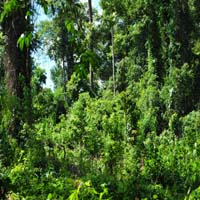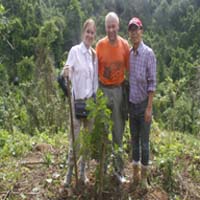Xishuangbanna Tropical Botanical Garden (XTBG) is working with BGCI on the restoration of a tropical forest remnant with the aid of historical records and ex situ plant collections. Focussing on the conservation of remnant rainforest fragments and pilot restoration of degraded sites in Xishuangbanna National Nature Reserve, a survey was initiated in the first part of 2013, to obtain an overview of the plant species composition of the entire area where restoration work is planned. More specifically, a forest fragment near Mangyangguan village was surveyed to update earlier species lists and identify restoration needs. Despite the high level of degradation and invasive species including the neotropical Chromolaena odorata, more regeneration of rainforest tree species than expected was found. Based on the survey, a draft list of 67 tree species has been established for consideration in the initial tree-planting efforts. Cultivated in Xishuangbanna Tropical Botanical Garden’s nurseries, over three hundred saplings of 16 native species of local provenance were planted in the sites of Manyangguang village and Menglun town. Trial plantings with native species have continued over the last year. In 2015, work will continue to support education programmes at local schools, involving students in some practical work to remove invasive species and planting saplings. Additional training in restoration techniques will also be carried out for local community representatives. Source: http://www.erabg.org/project/37/ Related news: Restoration of a tropical forest remnant with the aid of historical records and ex situ plant collections, YunnanLocal project coordinator: Xishuangbanna Tropical Botanical Garden (XTBG), Jinghong The overall goal of this project is to build stronger public support for the restoration of tropical forests remnants on limestone near the Xishuangbanna National Nature Reserve, an area that holds more than 10% of China’s vascular flora. The project focuses on two pilot restoration sites of forest fragments near Manyangguang village and Menglun town, with the intention to demonstrate the potential to reverse biodiversity decline and replicate successful approaches in other natural forest remnants of the region. In 2013, comprehensive field surveys in the trial plots were carried out and invasive species were removed. Cultivated in Xishuangbanna Tropical Botanical Garden’s nurseries, over three hundred saplings of 16 native species of local provenance were planted in the sites of Manyangguang village and Menglun town. Trial plantings with native species have continued over the last year. In 2015, BGCI would like to continue supporting educational activities at primary and middle school levels, and use the pilot restoration sites for field studies and practical work by the schools. An additional training in restoration techniques will be held for local community representatives. These activities also aim to further promote the restoration work implemented by Xishuangbanna Tropical Botanical Garden in the region, to seek enhanced support from other agencies and organisations in support of the development of a longer term strategy for the recovery and conservation of China’s tropical forest remnants. URL: http://www.bgci.org/ourwork/chinaproject3 |



